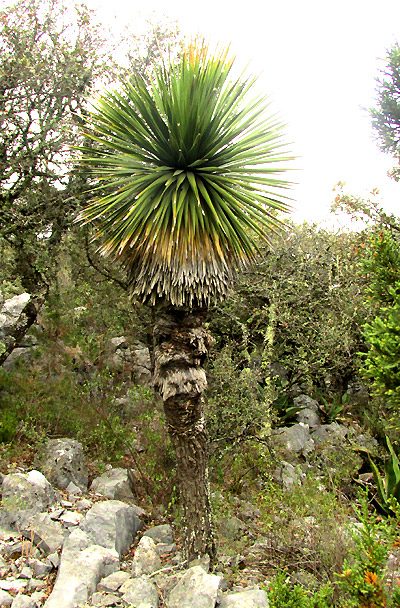Excerpts from Jim Conrad's
Naturalist Newsletter
Entry from field notes dated June 29, 2023, taken along road atop ridge forested largely of low-growing Quercus laeta, ridge rising on the southwestern side of Curva de la Doctorcilla, which is near km 18 on the branch road beginning at El Campamento and continuing to El Doctor, and which is numbered Hwy 120, though it branches off the main Hwy 120 running between San Juan del Río and Jalpan; limestone bedrock; elevation ~2930m (~9600 ft), Querétaro, MÉXICO, (N20.85971°, W99.60541°)
SPANISH DAGGER

The Yuccas of this region haven't been studied; you can't just "key them out" using a flora. From various sources, it appears that in these mountains of eastern Querétaro state, we can look for four species. Two of those species, Yucca filifera and Yucca carnerosana, differ from the above by bearing conspicuous, white, slender, curly and somewhat stiff filaments up to finger long or so, while the above yucca's leaves look like this:

A third species found in this general area is the poorly known Queretaro Yucca, Yucca queretaroensis, occurring only in a handful of locations in upland central Mexico, mainly here in Querétaro. However, that species's leaves are almost like long needles, less than 5mm wide (3/16th inch).
That leaves us with YUCCA TRECULIANA, in English usually known as Spanish Dagger, though that name is used by any number of yucca species.
Yucca treculiana is native from southern Texas and New Mexico south to Oaxaca in Mexico. It's most abundant in northeastern Mexico, with scattered occurrences in the Mexican uplands. This is the first time I've seen it in this region, so it's not so common here, though in places Yucca filifera is abundant, the most conspicuous feature of the landscape. The Flora of North America describes Yucca treculeana as reaching 7m tall (23ft), with older individuals branching.
As with many yucca species, the leaves of Yucca treculeana traditionally have been used as thatching, and fibers from the leaves for making twine, rope and weaving goods. In earlier times the small, fleshy fruits were fermented to make an alcoholic drink.
Nowadays the species often is planted as an ornamental in rock gardens, as well as along the Mediterranean coast. However, when planted beyond its native area, where the right species of pollinating yucca moth isn't found, it doesn't develop fruits.